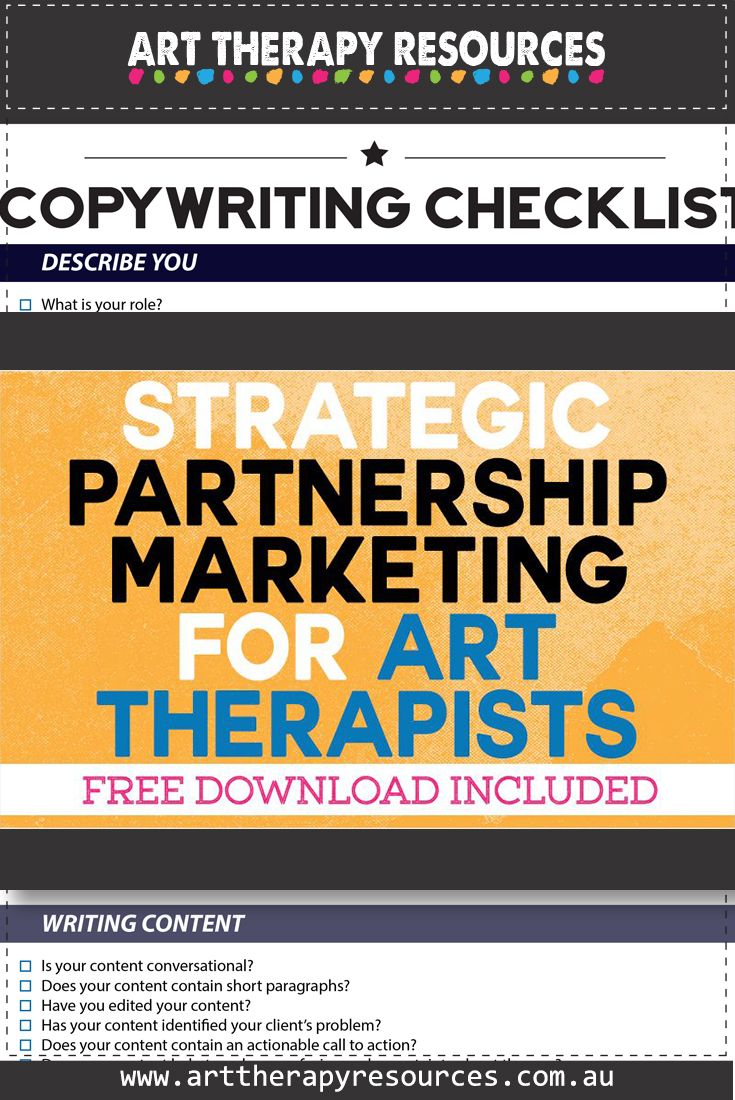THIS POST INCLUDES:
1. What is Collaborative Marketing
2. Forming Strategic Partnerships
3. Creating Marketing Strategies
4. Free Download Copywriting Checklist
WHAT IS COLLABORATIVE MARKETING

Marketing is pivotal for expanding your client base and fostering growth. Strategic partnerships within the mental health community serve as an essential tool, offering art therapists the opportunity to collaborate, share resources, and build professional credibility. Collaborative marketing, in this context, is not merely a tactic but a meaningful process where shared efforts lead to wider audience engagement and collective improvement of therapeutic services.
The Essence of Collaborative Marketing
Collaborative marketing revolves around the idea that partnerships between professionals can significantly enhance visibility and credibility, thus allowing art therapists to reach new and diverse audiences. For art therapists, who often work independently in private practice, collaborative marketing offers an avenue to join forces with other professionals. These partnerships—whether with psychologists, social workers, or community organizations, allow for pooling of resources and efforts in ways that would be more difficult to achieve alone.
This strategic approach creates opportunities for cross-promotion, joint events, or even shared content that resonates with both professional peers and potential clients. Collaborative marketing amplifies the message of mental health and wellness through creativity and expression, offering a unified voice to reach people who may benefit from art therapy but are unaware of its existence or potential.
Rather than viewing marketing as a one-sided push for services, collaboration places emphasis on the idea of shared responsibility and mutual benefit. By aligning with other professionals whose goals complement those of the art therapist, both parties can create comprehensive approaches to care that appeal to a broader client base.
Benefits of Strategic Partnerships in Marketing
Strategic partnerships offer numerous benefits, making them a vital component of an art therapist’s marketing strategy. One of the most immediate advantages is increased exposure. By collaborating with established professionals, art therapists can access an already-engaged audience that may not have been reached through traditional marketing efforts.
Moreover, these partnerships foster credibility. When clients or other professionals witness a therapist’s ability to collaborate effectively within a multidisciplinary framework, it reinforces their professional standing and expertise. This is particularly important in a field like art therapy, where potential clients may be unfamiliar with its benefits or be unsure of how it fits within the broader landscape of mental health care.
Another key advantage is resource sharing. Strategic partnerships allow therapists to share marketing costs, event coordination responsibilities, or content creation efforts. By co-hosting workshops, webinars, or events, art therapists can divide the workload while maximizing the potential client engagement. Joint marketing efforts can mean more comprehensive campaigns and greater outreach, creating a ripple effect that benefits all involved.
Strategic partnerships can also serve as a vehicle for continued professional development. Working alongside other experts opens up pathways for learning, reflection, and the exchange of ideas. This allows art therapists to stay updated on the latest trends and techniques within the mental health field while integrating creative approaches that align with their therapeutic practices.
Building Alliances: A Supportive Network
Building alliances is crucial in the mental health field, where the ability to create a supportive network not only benefits therapists but also their clients. For art therapists, forming strong alliances creates a foundation upon which they can grow their practice sustainably. These partnerships allow for an exchange of knowledge, resources, and referrals, contributing to a robust support system that serves both professionals and their clients.
In a collaborative framework, therapists become part of a larger network that allows for comprehensive care. For example, an art therapist who partners with a trauma specialist can refer clients in need of specific trauma interventions, while the trauma specialist can refer clients who may benefit from creative expression through art therapy. This reciprocity enhances the services provided to clients and establishes the art therapist as a trusted and integral part of the broader mental health landscape.
By focusing on alliances that align with their therapeutic approaches and values, art therapists also ensure that they are building relationships that are sustainable and beneficial in the long term. The strength of these alliances lies in the shared commitment to improving client outcomes through holistic and multifaceted approaches to care.
FORMING STRATEGIC PARTNERSHIPS

To successfully form strategic partnerships, art therapists must take a deliberate approach, seeking out collaborators whose values and goals are complementary. This process often begins with identifying professionals or organizations that have a similar client base or therapeutic outlook. Whether it’s other mental health professionals, organizations, or community groups, these partnerships should be mutually beneficial and aligned with their mission to support mental and emotional well-being.
Communication is key in establishing a solid partnership. Art therapists should clearly articulate their goals, what they offer as a professional, and how they believe a collaboration could be beneficial for both parties. Establishing clear boundaries and expectations early on ensures that the partnership will be productive and satisfying for everyone involved.
Moreover, art therapists should look for opportunities where their expertise can complement the services offered by potential partners. For instance, if working with a physical therapy practice, an art therapist could provide workshops for managing pain through creative expression, while the physical therapist could provide insights on how the body physically responds to pain. Together, they create a more holistic approach to healing for clients.
Joint marketing initiatives, such as creating collaborative social media content, co-hosting events, or cross-promoting services, can then emerge from these partnerships. These efforts not only expand each party’s reach but also reinforce the importance of interdisciplinary care in promoting mental and emotional well-being.
Collaborative Workshops and Events
Workshops and events provide excellent platforms for collaborative marketing. Art therapists can join forces with other professionals to offer engaging, educational experiences that showcase the benefits of art therapy in a collaborative context. These events can range from hands-on art-making sessions to discussions about mental health, mindfulness, or other important psychological topics.
Workshops allow potential clients to experience art therapy firsthand, while collaborations with other mental health professionals provide opportunities for integrated learning. For example, a workshop focused on stress reduction could combine art therapy exercises with guided meditation or breathing techniques. Such collaborations allow participants to see how creative expression can complement other therapeutic interventions.
By hosting or co-hosting events, art therapists position themselves as experts in their field while gaining exposure to new client demographics. Workshops and events can also be powerful networking opportunities, helping therapists connect with other professionals who may lead to future partnerships or referral opportunities.
Collaborative Marketing and Social Media Strategies
Social media offers an ideal platform for collaborative marketing. Through joint social media campaigns, art therapists can tap into each other’s audiences, amplifying their reach and building credibility. These campaigns can take various forms, from Instagram takeovers, where one partner features on the other’s account for a day, to joint content creation that highlights the benefits of both professionals’ services.
For example, an art therapist could collaborate with a professional to create content that discusses the importance of creative expression in mental health. By sharing this content across multiple platforms, both parties increase their visibility while promoting a holistic approach to mental wellness.
Social media also allows for the sharing of client success stories (with appropriate consent and confidentiality), collaborative giveaways, and virtual events such as webinars. These interactive initiatives create dynamic ways to engage with potential clients and demonstrate the effectiveness of art therapy in conjunction with other wellness practices.
CREATING MARKETING STRATEGIES

Collaborative partnerships not only expand reach but also provide opportunities to share resources, knowledge, and expertise in a way that benefits both the therapist and the community. This section explores various strategies for creating, nurturing, and leveraging partnerships to enhance marketing efforts.
Identifying Compatible Partners: Aligning Values
Partnerships are most successful when both parties share common values and goals. For art therapists, this means aligning with individuals or organizations that support holistic approaches to mental health care and value creative, expressive interventions. To identify compatible partners, art therapists should begin by clarifying their own values, mission, and the core message they wish to communicate through their work.
To further ensure compatibility, it’s important to engage in conversations that explore each party’s approach to client care, communication style, and long-term goals. Collaborative partnerships should feel like a natural fit, where both parties are motivated to work together towards shared outcomes, such as improving mental health care in their community.
Collaborative Workshops and Events: Showcasing Expertise
Collaborative workshops and events are highly effective tools for marketing art therapy services. These joint ventures allow art therapists to showcase their expertise, while also creating engaging and informative experiences for participants. In a workshop setting, art therapists can introduce potential clients to the benefits of art therapy, offer demonstrations, and provide hands-on experiences that allow attendees to interact with art-making as a therapeutic tool.
Collaborating with other professionals adds further value to these events. For example, an art therapist might team up with a psychologist to offer a workshop on trauma recovery, where the art therapist leads a creative exercise while the psychologist explains the cognitive and emotional aspects of healing from trauma. Such collaborations not only enhance the learning experience but also demonstrate the art therapist’s ability to work within an interdisciplinary framework, thus increasing credibility and trust.
Joint events can take many forms, including community wellness fairs, mental health awareness days, or even virtual events like webinars and online workshops. These platforms provide ample opportunities for art therapists to network, build relationships, and establish themselves as thought leaders in the mental health community.
Creating Collaborative Content
Content creation is a cornerstone of any marketing strategy, and collaborating with partners to create joint content offers a dynamic way to share expertise and engage new audiences. When two professionals come together to create content, they combine their unique perspectives, resulting in more robust and compelling material. This can take the form of blog posts, podcasts, videos, or infographics that convey the shared mission of improving mental health and wellness.
Joint Content Creation: The Power of Shared Narratives
Joint content creation allows art therapists and their partners to craft shared narratives that resonate with a broader audience. By pooling knowledge and expertise, collaborators can produce richer, more diverse content that reflects both the creative and psychological dimensions of mental health care. For example, an art therapist and a clinical psychologist might co-author a blog post on managing anxiety through art and cognitive behavioral therapy (CBT), offering readers a comprehensive approach to self-care.
Content can also be multimedia-based, such as creating a series of short videos that showcase how art therapy can be used to support specific mental health conditions. A series on trauma recovery, for example, could include one video explaining the theoretical underpinnings of trauma work, followed by a video demonstrating art therapy exercises that aid in trauma processing.
Webinars and Panel Discussions: Thought Leadership Collaborations
Webinars and panel discussions are effective ways to position art therapists as thought leaders within the mental health community. These virtual platforms offer an opportunity to engage directly with potential clients and other professionals while sharing valuable insights and therapeutic strategies.
Art therapists can either host their own webinars or participate as guest speakers in panel discussions organized by their partners. For instance, an art therapist might join a webinar hosted by a community mental health organization to discuss the benefits of art therapy in treating anxiety or depression. By sharing the stage with other experts, the therapist not only gains visibility but also demonstrates their competence and collaborative spirit.
Panel discussions, especially those focused on current mental health topics or innovative therapeutic techniques, provide a forum for art therapists to discuss their practice and how art therapy can complement other forms of mental health treatment. These discussions can be recorded and repurposed as content for blogs, podcasts, or social media, thus extending the life and reach of the collaborative effort.
Leveraging Social Media and Online Platforms
Social media and online platforms are critical components of any marketing strategy. Art therapists can use these tools to amplify their presence, engage with clients, and foster community connections. By collaborating with partners on social media campaigns or online resources, therapists can further increase their visibility and expand their reach.
Social media offers art therapists a dynamic canvas for collaborative marketing. Joint social media campaigns can help reach a larger and more diverse audience while promoting both the art therapist’s services and their partner’s offerings. For example, an art therapist could collaborate with a mindfulness coach on an Instagram series focusing on mental wellness, with each professional offering daily tips or exercises to their combined audience.
Online Collaborative Resources: Creating a Hub
Art therapists can also create online hubs for collaborative resources that serve as valuable repositories for mental health information. These online platforms—whether in the form of a joint blog, resource library, or online community—solidify partnerships and provide a comprehensive source of support for clients.
A collaborative blog, for instance, could feature regular contributions from both the art therapist and their partners, covering a wide range of topics related to mental health, creative expression, and wellness. Online resource libraries, stocked with articles, videos, and worksheets created by both the therapist and their collaborators, provide clients with easy access to self-help tools and educational material.
These online hubs can also foster a sense of community among clients, who can engage with the content, participate in discussions, and access a wide range of mental health resources in one place. By building these collaborative online platforms, art therapists can establish themselves as leaders in the mental health field while providing tangible value to their clients.
Collaborative marketing strategies offer art therapists a valuable way to expand their practice, reach new audiences, and enhance their professional visibility. By aligning values with compatible partners, creating joint content, and leveraging social media and online platforms, art therapists can strengthen their marketing efforts while continuing to provide high-quality care. These strategies not only promote the individual therapist but also contribute to the broader mental health and wellness community, ultimately supporting the goal of improving mental health care for all.
FREE DOWNLOAD: Art Therapy Exercise
SIGN UP below to gain access to our RESOURCE LIBRARY and download the FREE Copywriting Checklist.

BUILD YOUR ART THERAPY REFERENCE MATERIALS:
Pin this image to your Pinterest board.

SHARE KNOWLEDGE & PASS IT ON:
If you’ve enjoyed this post, please share it on Facebook, Twitter, Pinterest. Thank you!
